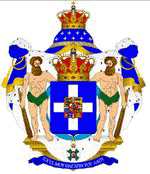.
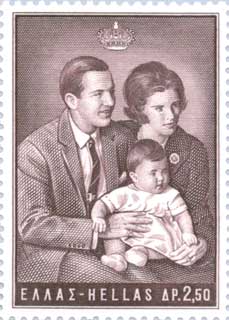

Constantine II (Greek: Κωνσταντίνος Βʹ, Konstantínos II; pronounced [ˌkonstaˈdinos ðefˈteros]; 2 June 1940 – 10 January 2023)[3] was the last King of Greece, from 6 March 1964 until the abolition of the Greek monarchy on 1 June 1973.
Constantine was the only son of King Paul and Queen Frederica of Greece. As his family was forced into exile during the Second World War, he spent the first years of his childhood in Egypt and South Africa. He returned to Greece with his family in 1946 during the Greek Civil War. King George II died in 1947, and Constantine's father became the new king, making Constantine the crown prince.
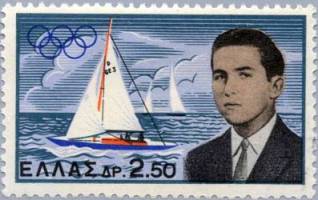
He acceded as king in 1964 following the death of his father, King Paul. Later that year he married Princess Anne-Marie of Denmark with whom he eventually had five children. Although the accession of the young monarch was initially regarded auspiciously, his reign saw political instability that culminated in the Colonels' Coup of 21 April 1967. The coup left Constantine, as the head of state, little room to manoeuvre since he had no loyal military forces on which to rely. As a result, he reluctantly agreed to inaugurate the junta on the condition that it be made up largely of civilian ministers. On 13 December 1967, Constantine was forced to flee the country, following an unsuccessful countercoup against the junta. He remained (formally) the head of state in exile until the junta abolished the monarchy on 1 June 1973. The 1973 Greek republic referendum on 29 July, ratified the abolition. There were questions concerning the validity of this referendum and whether people were pressured to vote for a republic. Therefore, a fresh referendum was held after the restoration of democracy in 1974. This second referendum was held after the fall of the junta as the 1974 Greek republic referendum on 8 December 1974 and confirmed the abolition of the monarchy and the establishment of the Third Hellenic Republic. Constantine, who was not allowed to return to Greece to campaign,[4] accepted the results of the plebiscite.[5] He died in Athens on 10 January 2023, following increased health problems.
Constantine was also a competitive sailor and Olympian, winning a gold medal in the 1960 Rome Olympics in the Dragon class, and later serving on the International Olympic Committee. Along with his fellow crew members of the Nireus sailing vessel, he was named one of the 1960 Greek Athletes of the Year.
Early life
Prince Constantine's parents Prince Paul and Princess Frederica in 1939
Constantine was born in the afternoon of 2 June 1940 at his parents' residence, Villa Psychiko at Leoforos Diamantidou 14 in Psychiko, an affluent suburb of Athens.[6] A nephew of the then Greek king, George II, he was the second child and only legitimate son of the childless king's younger brother and heir presumptive, Crown Prince Paul.[7] His mother, Princess Frederica of Hanover, was the only daughter of Ernest Augustus, Duke of Brunswick and Princess Victoria Louise of Prussia.[8]
At birth Prince Constantine had an elder sister, Princess Sofia, born in 1938.[7] However, since male-only primogeniture governed the succession to throne in Greece at the time, the birth of a male heir to the throne had been anxiously awaited by the Greek royal family, and the newborn prince was therefore received with joy by his parents.[9][10] His birth was celebrated with a 101–gun salute from Mount Lycabettus in Athens, which according to tradition announced that the newborn was a boy.[11] According to Greek naming practices, being the first son, he was named after his paternal grandfather, Constantine I.[12] At his baptism in Athens, the Hellenic Armed Forces acted as his godparent.[13]
World War II and the exile of the Royal Family
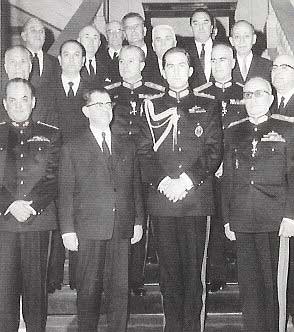
King Constantine II surrounded by the junta Government at the swearing-in Ceremony of the Dictators
Constantine's birth took place during the beginning of World War II. He was just a few months old when Fascist Italy on 28 October 1940 invaded Greece from Albania, beginning the Greco-Italian War. The Greek Army was able to halt the invasion temporarily and was able to push the Italians back into Albania.[14][15][16] However, the Greek successes forced Nazi Germany to intervene. The Germans invaded Greece and Yugoslavia on 6 April 1941, and overran both countries within a month, despite British aid to Greece in the form of an expeditionary corps.[17][18] On 22 April 1941 Princess Frederica and her two children, Sofia and Constantine, were evacuated to Crete in a British Short Sunderland flying boat along with most of the Greek royal family. The next day they were followed by King George and Prince Paul. However the imminent German invasion of Crete quickly made the situation untenable and Constantine and his family were evacuated from Crete to Egypt on 30 April 1941, a fortnight before the German attack on the island.[19] In Alexandria, the exiled Greek royals were welcomed by the Greek diaspora, which provided them with lodging, money and clothing.[20] The presence of the Greek royal family and government began to worry King Farouk I of Egypt and his pro-Italian ministers. Constantine and his family therefore had to seek another refuge where they could get through the war and continue their fight against the Axis powers. As the King George VI of the United Kingdom opposed the presence of Princess Frederika and her children in Britain, it was decided that King George and Prince Paul could take up residence in London, where a government-in-exile was set up, while the rest of the family could seek refuge in then-Union of South Africa.[21][22]
On 27 June 1941, most of the Greek royal family therefore set off for South Africa on board the Dutch steamship Nieuw Amsterdam, which arrived in Durban on 8 July 1941.[20][23][24] After a two-month stay in London, Prince Paul left for England with his brother, and Constantine then barely saw his father again for the next three years.[25] [26] The rest of the family settled in Cape Town, where the family was joined by a younger sister, Princess Irene, born in 1942.[7]. Prince Constantine, his sister, their mother and their aunt Princess Catherine were initially lodged with South African Governor-General Patrick Duncan at his official residence Westbrooke in Cape Town.[27][28]
The group subsequently moved several times until they settled in Villa Irene in Pretoria with Prime Minister Jan Smuts, who quickly became a close friend of the exiled Greeks.[27][29][30] From early 1944, the family again took up residence in Egypt. In January 1944, Princess Frederika was reunited with her husband in Cairo, and their children joined them in March of that year. Despite their difficult financial circumstances, the family then established friendly relations with several Egyptian personalities, including Queen Farida, whose daughters were roughly the same age as Prince Constantine, Princess Sofia and Princess Irene.[31]
After World War II and return to Greece
At the end of World War II, Nazi Germany gradually withdrew from Greece in 1944. While the majority of exiled Greeks were able to return to their country, Konstantin and his family had to remain in exile because of the growing republican opposition at home. Britain tried to reinstate King George II, who remained in exile in London, but most of the resistance, in particular the communists, were opposed. Instead, King George had to appoint from exile a Regency Council headed by Archbishop Damaskinos of Athens, who immediately appointed a republican-majority government headed by Nikolaos Plastiras.[32][33][34] King George, humiliated, ill and powerless, considered abdicating for a time in favour of his brother, but eventually decided against it.[32][33][34]
Prince Paul, who was more combative but also more popular than his brother, would have liked to return to Greece as heir to the throne as early as the liberation of Athens in 1944, as he believed that back in his country he would have been quickly proclaimed regent, which would have blocked the way for Damaskinos and made it easier to restore the monarchy.[35]
However, the unstable situation in the country and the polarization between communists and bourgeois allowed the monarchists to return to power after the parliamentary elections of March 1946. After becoming Prime Minister, Konstantinos Tsaldaris organised a referendum on 1 September 1946 with the aim of allowing George II to return to the throne. The majority in the referendum was in favour of reinstating the monarchy, at which time Prince Paul and Princess Frederika also returned to Greece with their children. In a country still suffering from rationing and deprivation, the heir to the throne, his wife and their three children moved back to the villa in Psychikó. It was there that the heir to the throne and his wife chose to start a small school, where Constantine and his sisters received their first education[36] under the supervision of Jocelin Winthrop Young, a British disciple of the German Jewish educator Kurt Hahn.[37][38][39]
The tension between communists and conservatives led in the following years to the Greek Civil War, fought mainly in northern Greece. The Civil War ended in 1949 with the victory of the bourgeois and royalists, supported by Britain and the United States.[40]
Crown Prince
Education
Prince Constantine with United States President Dwight Eisenhower, 1959
In the midst of the Civil War, on 1 April 1947, King George II died. Thus, Constantine's father ascended the throne as King Paul I, and Constantine himself became Crown Prince at the age of six.[41][42] He then moved with his family from the villa in Psychiko to the Tatoi Palace at the foot of the Parnitha Mountains in the northern part of the Attica peninsula.[43]
The first years of his father's reign did not bring great upheavals in the prince's daily life. Constantine and his sisters Sophie and Irene were brought up relatively simply, and communication was at the heart of the pedagogy of their parents, who spent all the time they could with their children.[44][45] Supervised by an army of British governesses and tutors, the children spoke English in the family but were also fluent in Greek.[46] Until he was nine, Constantine continued to be educated with his sisters and other companions from Athens' better bourgeoisie in the villa at Psychiko.[37]
After that age, King Paul decided to begin preparing his son for the throne. He then started at the Anávryta lyceum in Marousi northeast of Athens, which also followed Kurt Hahn's pedagogy. He attended school there as a boarder in the 1950s, while his sisters attended school in Salem, Germany.[37][47][48] From 1955, Constantine served in all three branches of the Hellenic Armed Forces, attending the requisite military academies. He also attended the NATO Air Force Special Weapons School in Germany, as well as the University of Athens, where he took courses in the school of law.[8]
In 1955 he received the title of Duke of Sparta.[49]
Sailing and the Olympic Games
Constantine on board "Nireus", 1960
Constantine was an able sportsman. In 1958, King Paul gave his son a Lightning class sailing boat for Christmas. Subsequently, Crown Prince Constantine spent most of his free time training with the boat on the Saronic Gulf. After a few months, the Greek Navy gave the prince a dragon boat, with which he decided to participate in the 1960 Summer Olympics in Rome.[50] At the opening of the Games in Rome, he was the flag bearer for the Greek team.[51] He won an Olympic gold medal in sailing (dragon class), which was the first Greek gold medal in sailing since the Stockholm 1912 Summer Olympics.[52] Constantine was the helmsman of the boat "Nireus" and the team was formed by Odysseus Eskitzoglou and Georgios Zaimis.[53]
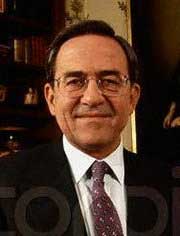
Constantine DeGrecia
He was also a strong swimmer and had a black belt in karate, with interests in squash, track events, and riding.[8] In 1963 Constantine became a member of the International Olympic Committee (IOC). He resigned in 1974 because he was no longer a Greek resident, and was made an Honorary IOC Member.[54] He was an honorable member of the International Soling Association[55] and President of the International Dragon Association.[56]
Reign
Accession
In 1964, Paul I's health deteriorated rapidly. He was diagnosed with stomach cancer and was operated on for an ulcer in February. Prior to this, Constantine had already been appointed regent for his ailing father while waiting for his recovery.[57] During this regency, Constantine limited himself to signing decrees and appointing members of the government, as well as accepting their resignations.[49] However, as the king's condition worsened, the crown prince went to Tinos to get an icon considered miraculous by the Greek Orthodox Church. The holy image, however, was not enough to cure the sovereign, and on 6 March 1964, King Paul died and the 23-year-old Constantine succeeded him as King of the Hellenes.[58][59][60] The new king ascended the throne as Constantine II, although some of his supporters preferred to call him Constantine XIII to emphasize the continuity between the former Byzantine Empire and the Kingdom of Greece.[61] On 23 March he was sworn in before the Parliament and was invested as chief of the armed forces with the highest ranks (marshal, rear admiral and chief of staff).[53][62]
Due to his youth, he was also perceived as a promise of change. Greece was still feeling the effects of the Civil War and society was strongly polarised between the royalist/conservative right and the liberal/socialist left. The accession of Constantine coincided with the recent election of Centrist George Papandreou as prime minister in February 1964, which ended 11 years of right-wing rule by the National Radical Union (ERE). It was hoped that the new young king and the new prime minister would be able to overcome past dissensions.[61]
Apostasia of 1965
Main article: Apostasia of 1965
Anne-Marie and Constantine with Prince Bernhard of the Netherlands in Shipol, 1966
Constantine took the reins of the Kingdom at a time when Greek society was experiencing economic and employment growth, but political crises and violent social protests.[63] Political instability worsened in 1965. At the meeting with the Prime Minister George Papandreou that took place on 11 July 1965 in Korfu, Constantine requested that those implicated in the ASPIDA scandal, in which several officers, captains and majors tried to thwart and pre-empt attempts by the extreme right-wing military to seize power, be referred to a military tribunal.[53][64] Papandreou agreed, and raised with him his intention to dismiss the then minister of defence Petros Garoufalias so that he could take charge himself of the ministry.[53] Constantine refused, as the scandal wrongly implicated the prime minister's son, Andreas Papandreou.[53] After several clashes by letter between the monarch and the prime minister, Papandreou resigned on 15 July.[65][66] Following the resignation, at least 39 members of Parliament left Center Union.[63]
Constantine appointed a new government led by Georgios Athanasiadis-Novas, Speaker of the Parliament, and formed by defectors disaffected with the Papandreous (the ‘Apostates’).[65][66] Soon thousands of citizens took to the streets to protest against Constantine's decision, unprecedented protests that led to clashes with the Cities Police.[63][65] On 21 July the protests in the center of Athens came to a head, and in one of these clashes a policeman killed the 25-year old student Sotiris Petroulas, leader of the student movement and of the "Lambrakis Youth". His assassination became a symbol of the protests and his funeral was massive.[66][63] Nova's government did not receive a vote of confidence from Parliament and resigned on 5 August. The two big parties, National Radical Union and Center Union, asked Constantine to call elections, but he asked Stefanos Stefanopoulos to form a government but finally ordered Ilias Tsirimokos to form a government on 18 August but he did not receive the vote of confidence of the Parliament on 28 August either. Constantine finally ordered Stefanopoulos to form a government and obtained the parliamentary confidence on 17 December 1965. An end to the crisis seemed in sight when on 20 December 1966, Papandreou, ERE leader Panagiotis Kanellopoulos and the king reached a resolution: elections would be held under a straightforward system of proportional representation where all parties participating agreed to compete, and that, in any outcome, the command structure of the army would not be altered.[67] The third "apostate" government fell on 22 December 1966, and was succeeded by Ioannis Paraskevopoulos, who was to govern until the parliamentary elections of 28 May 1967 which were expected to favor a victory for Georgios Papandreou's Centre Union.[68][69] Paraskevopoulos resigned and Kanellopoulos stepped in to fill the role of the Prime Minister on 3 April 1967 until the election.[70]
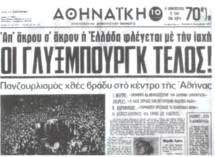
Cover of Greek newspaper "Athinaiki" about the polling results: From corner to corner, Greece is burning down with one voice: "The end of the Glücksburgs!"
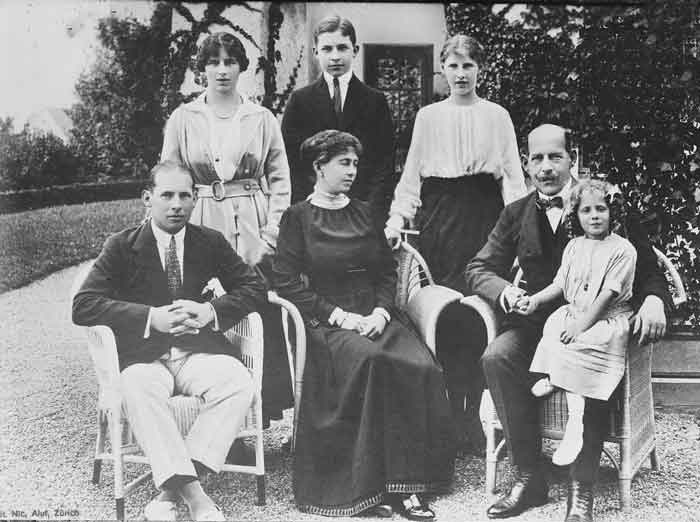
The Family of King Constantine I
Family status
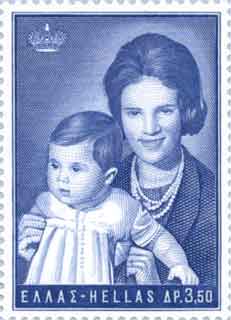
Anne Marie with Alexia
Greek dictatorship 1967–1974
Main article: Greek junta
There have been many suspicions of Constantine's and his mother's interest in a coup d'état since at least mid-1965. US Army Attaché Charles Perkins reported that military right-wing group "Sacred Bond of Greek Officers" (IDEA) "plans for coup and military dictatorship in Greece", that Constantine was aware and that the group was aware that any operation in this direction with the US must have the permission of the king.[71] According to Charilaos Lagoudakis, a U.S. State Department expert on Greece, by mid-1966 Constantine had already approved a coup plan.[71] On the other hand, historian C.M. Woodhouse rejects any involvement of Constantine in the conspiracy.[71]
A traditionalist, right-wing nationalist group of middle-ranking army officers led by Colonel George Papadopoulos took action first and staged a coup d'état on 21 April, being the fear of a "communist danger" as the main excuse.[69] Tanks rolled through the streets of Athens, a few rifle shots were heard and military songs were played on the radio until the announcement that "The Hellenic Armed Forces have undertaken the governance of the country" was made public. Some high-ranking politicians were arrested as well as the commander-in-chief of the army.[72] The coup leaders met Constantine at his residence in Tatoi at about 7 a.m, which was surrounded by tanks to prevent resistance and when the coup seemed to have succeeded bloodless. Constantine later recounted that the officers of the tank platoons believed they were carrying out the coup under his orders.[73] They asked Constantine to swear in the new government. Despite the urging of the detained Prime Minister Knellopoulos that the king resist the coup, Constantine compromised with them to avoid bloodshed and in the afternoon swore in the new military government with Supreme Court prosecutor Konstantinos Kollias as prime minister.[69] On 26 April, in his speech on the new regime, he affirmed that "I am sure that with the will of God, with your efforts and above all with the help of the people, the organization of a State of Law, an authentic and healthy democracy".[66] According to the then-U.S. ambassador to Greece Phillips Talbot, Constantine expressed his anger at this situation, revealed to him that he no longer had control of the army and that "incredibly stupid extreme right-wing bastards with control of the tanks are leading Greece to destruction".[74]
Since his inauguration as king, Constantine already manifested his disagreements with the then Archbishop of Athens and All Greece Chrysostomos II. With the military dictatorship, he had the opportunity to be removed from the Greek Orthodox Cephaly, in fact it was one of the first measures with which Constatnine collaborated with the Junta. On 28 April 1967 Chrysostomos II, was retained and was forced to resign after having to sign one of the two versions of the letter brought to him by an official of the royal palace. Finally Ieronymos Kotsonis was elected as metropolitan by Junta's and Constantine's proposal on 13 May 1967.[75]
Royal countercoup of 13 December 1967 and exile
From the outset, the relationship between Constantine and the regime of the colonels was an uneasy one, especially when he refused to sign the decree imposing martial law and asked Talbot to flee Greece in an American helicopter with his family.[76][74] But the administration of U.S. President Lyndon B. Johnson was to keep Constantine in Greece to negotiate with the junta for the return of democracy.[74] The presence of the United States Sixth Fleet in the Aegean Sea outraged the Junta government, which forced Constantine to get rid of his private secretary Michail Arnaoutis [el], but he refused.[74] The king and his entourage was beginning to glimpse the fall of the monarchy.[74] Constantine visited the United States on those days and in the meeting with Lyndson Johnson asked for military aid for the counter-coup he was planning, but without success.[74] The Junta, however, had information about Constantine's conspiracy.[74]
King Constantine with US president Lyndson B. Johnson in the Oval Office, 11 September 1967
Constantine began negotiations with the officials loyal to him in the summer of 1967. His objective was to mobilize the units of the army loyal to him and to restore parliamentary legitimacy. The action was planned by Lieutenant General Konstantinos Dovas.[74] Several military authorities joined the plan: lieutenant general Antonakos, chief of the air force, Konstantinos Kollias, tinent general Kehagias, Ioannis Manettas, brigadier generals Erselman and Vidalis, major general Zalochoris, and others, so it was expected that the counterattack would be successful.[74] The king communicated with Constantinos Karamanlis, exiled in Paris and aware of the plot, so that he would return to assume the post of prime minister if this movement was successful, but he refused.[74] The main objective of the plan drawn up by the movement was that all the units initiated would occupy Tessaloniki and the King would send a message to all the Greeks.[74] It would follow the tanking of Tempe and the defense of Lamia by the army in Larissa and the swearing in of a new government with the participation of the centrist Georgios Mavros and by the archbishop Ieronymos.[74] Constantine and the involved officals began to realize that the plan could fail as they didn't count on the active support of American intelligence, who were aware of the details of the plan.[74] They attempted a first movement for the military parade scheduled for 28 October, but Hellenic Army General Staff Odysseas Angelis refused to mobilize the units that Georgios Peridis [el] requested. Movement that, together with the visit of Constantine together with Peridis to some military divisions, were observed by the Junta.[74]
On the morning of 13 December 1967, the royal family flew to Kavala, east of Thessaloniki accompanied by Prime Minister Konstantinos Kollias who was informed at that moment of Constantine's plan. They arrived at 11:30 and were well received by the citizens.[74] But some conspirators were neutralized, such as General Manettas, and Odysseas Angelis informed all of Greece of the plan, asking everyone to obey his orders minutes before telecommunications were cut off.[74] By noon all the airbases except Athens had joined the royalist movement, and fleet leader Vice Admiral Dedes, before being arrested, ordered successfully the whole fleet sail towards Kavala in obedience to the king.[74] They did not manage to take Thessaloniki, and it soon became apparent that the senior officers were not in control of their units. This, along with the arrest of several officers, including the capture of Peridis that afternoon, and the delay in the execution of some orders, the countercoup failed.[74]
The Junta leaded by Georgios Papadopoulos, then and on the same day, appointed General Georgios Zoitakis as Regent of Greece, who was sworn in in Athens by Archbishop Ieronymos.[74] Constantine, the royal family and Prime Minister Konstantinos Kollias took off in torrential rain from Kavala for exile in Rome, where they arrived at 4 pm on 14 December and where they remained in exile through the rest of military rule (although he continued as king until 1 June 1973). He was never to return to Greece as a reigning king.[74]
Constantine stated, "I am sure I shall go back the way my ancestors did."[76] He said once to the Toronto Star:
I consider myself King of the Hellenes and sole expression of legality in my country until the Greek people freely decide otherwise. I fully expected that the (military) regime would depose me eventually. They are frightened of the Crown because it is a unifying force among the people.[8]
Throughout the dictatorship Constantine maintained contact with the Junta, maintaining direct communication with the colonels and kept the royal subsidy until 1973.[66] On 21 March 1972, Papadopoulos became Regent.[77] At the end of May 1973, senior officers of the Greek navy organized an abortive coup to overthrow the junta government, but failed.[66][62] The dictators considered Constantine to be involved, so on 1 June, with a constitutional act, Papadopoulos declared the abdication of the kings, the conversion to a presidential and parliamentary democracy and assumed the interim presidency of the Republic.[66][62] In June 1973, Papadopoulos condemned Constantine as "a collaborator with foreign forces and with murderers" and accused him of "pursuing ambitions to become a political leader".[8] The plebiscite of 29 July confirmed the end of the Greek monarchy and the reign of Constantine.[66][62]
Restoration of democracy and the referendum
Main article: Metapolitefsi
In July 1974, the events in Cyprus led to the downfall of the military regime, and Konstantinos Karamanlis returned from exile to become prime minister. The 1973 republican constitution was regarded as illegitimate, and the new administration issued a decree restoring the 1952 constitution. Constantine confidently awaited an invitation to return.[8] On 24 July he declared his "deep satisfaction with the initiative of the armed forces in overthrowing the dictatorial regime" and welcomed the advent of Karamanlis as prime minister.[78]
Following the accession of a civilian government in November 1974 after the first post-junta legislative election, Karamanlis called a referendum, held on 8 December 1974, on whether Greece would restore the monarchy or remain a republic.[66] Although he had been the leader of the traditionally monarchist right, Karamanlis made no attempt to restore the democratic constitution of 1952. The King was not allowed by the government to return to Greece to campaign for the restoration of constitutional monarchy. He was only allowed to broadcast to the Greek people from London on television. Analysts claim this was a deliberate act by the government to undermine any chance to restore the monarchy.[79]
Constantine, speaking from London, freely admitted his past mistakes. He claimed to have sound democratic intentions in the future and promised that his mother would stay away from the country.[8] Local monarchists campaigned on his behalf. The vote to restore the monarchy was only about 31% with most of the support coming from the Peloponnese region. Almost 69% of the electorate voted against the restoration of the monarchy and for the establishment of a republic.[8][66][62]
In exile
Portrait by Allan Warren, 1987
Constantine remained in exile for forty years after the vote in favour of the republic.[80] He was strongly discouraged from returning to Greece, and he did not return until February 1981, when the government allowed him to return for only a few hours, to attend the funeral of his mother, Queen Frederica, in the family cemetery of the former Royal Palace at Tatoi.
There were also legal disputes with the Greek state. In 1992 he concluded an agreement with the conservative government of Prime Minister Constantine Mitsotakis, ceding most of his land in Greece to a non-profit foundation in exchange for the former palace of Tatoi, near Athens, and the right to export a number of movables from Greece. The latter reportedly included privately owned art treasures from the royal palaces. As such, no formal account of what was removed was ever given or needed to be given. In 1993, Constantine visited Greece, but faced with government insecurity, he was asked to leave. In 1994, the second government of Andreas Papandreou passed new legislation reversing the 1992 agreement and stripping Constantine of his property in Greece and his Greek citizenship.
Constantine sued Greece at the European Court of Human Rights for €500 million in compensation for the seized property. He won a much smaller amount, receiving a monetary compensation of €12 million for the lost property, with a far smaller sum awarded to his unmarried younger sister, Princess Irene, and his aunt Princess Katherine.[81] The Greek government chose to pay out of the "extraordinary natural disasters" fund, but was not obliged by the court's decision to return any lands (the Court of Human Rights awards only monetary compensation).
"All I want is to have my home back and to be able to travel in and out of Greece like every other Greek. I don't have to be in Greece as head of state. I am quite happy to be there as a private citizen."[82]
—Constantine to The Sunday Telegraph in 2000.
Constantine, in turn, created the Anna Maria Foundation, to allocate the funds in question back to the Greek people for use in "extraordinary natural disasters" and charitable causes. The court decision also ruled that Constantine's human rights were not violated by the Greek state's decision not to grant him Greek citizenship and passport unless he adopts a surname. Constantine said of this, "The law basically said that I had to go out and acquire a name. The problem is that my family originates from Denmark and the Danish royal family haven't got a surname."[82] He accused the government of working "unjustly and vindictively", and believed that "the greatest insult in the world" is "for a Greek to be told he is not a Greek."
Later life
Constantine II and his wife arriving at the wedding of Victoria, Crown Princess of Sweden, and Daniel Westling, 2010
Constantine II in 2010
Following the abolition of the monarchy, Constantine repeatedly stated that he recognized the Republic, the laws, and the constitution of Greece. He told Time, "If the Greek people decide that they want a republic, they are entitled to have that and should be left in peace to enjoy it."[83]
Constantine and Anne-Marie for many years lived in Hampstead Garden Suburb, London, Constantine being a close friend of his second cousin Charles III, and a godfather to William, Prince of Wales, his second cousin once removed. He sold his house in Hampstead in 2013.[84]
Constantine was a patron of Box Hill School, a private school in Dorking, in the south of England.
In 2004, Constantine returned to Greece temporarily during the Athens Olympic Games as a member of the International Olympic Committee.[83] On 24 December 2004, Constantine and Anne-Marie and members of the former royal family visited the Presidential Mansion (the former Royal Palace) in Athens where Constantine met President Costis Stephanopoulos, who gave them a tour.
According to a nationwide 2007 survey of 2,040 households conducted on behalf of the newspaper To Vima, only 11.6% supported a constitutional monarchy. More than half of the respondents, 50.9%, considered that the dictatorship of the junta had brought benefits to Greece.[85]
During the 2008 Beijing and 2012 London Olympics, Constantine, in his role as honorary member of the International Olympic Committee, was the official presenter at the sailing medal ceremonies. He was Co-President of Honour of the International Sailing Federation with King Harald V of Norway, from 1994 on.[86]
In 2013, Constantine returned to reside in Greece.[84] He and his wife Anne-Marie purchased a villa in Porto Cheli, Peloponnese, residing there until they relocated to Athens in the spring of 2022.
In November 2015, his autobiography was published in three volumes by the national newspaper, To Vima.[87] It has not yet been published in English.
Death
Main article: Death and funeral of Constantine II of Greece
Constantine suffered multiple health problems in his final years, including heart conditions and decreased mobility.[88] He died of a stroke at the private Hygeia Hospital in Athens on 10 January 2023, at the age of 82.[89][90]
Marriage and children
Main article: Wedding of Constantine II of Greece and Princess Anne-Marie of Denmark
King Constantine II and Princess Anne-Marie on their wedding day
Constantine and his wife with their youngest children, Theodora and Philippos, by Allan Warren c. 1986
On 18 September 1964, in a Greek Orthodox ceremony in the Metropolitan Cathedral of Athens, he married Princess Anne-Marie of Denmark.[53]
The couple's children are:
Princess Alexia, born on 10 July 1965 at Mon Repos in Corfu. She was married on 9 July 1999 in London to Carlos Morales Quintana, they have 4 children.
Crown Prince Pavlos, born on 20 May 1967 at Tatoi Palace in Athens. He was married on 1 July 1995 in London to Marie-Chantal Miller, they have 5 children.
Prince Nikolaos, born on 1 October 1969 at Casa di Cura Privata Nuova Villa Claudia in Rome. He was married on 25 August 2010 in Spetses to Tatiana Elinka Blatnik.
Princess Theodora, born on 9 June 1983 in St Mary's Hospital, London, who is pursuing an acting career.
Prince Philippos, born on 26 April 1986 in St Mary's Hospital, London.[91] He works as a hedge fund analyst in New York.[92] He married Nina Nastassja Flohr on 12 December 2020 in St. Moritz in a civil ceremony. Their religious wedding ceremony was held at the Metropolitan Cathedral of Athens on 23 October 2021.
Ancestry
Ancestors of Constantine II of Greece
Titles, styles and honours
Titles and styles
Until 1994, Constantine's official Greek passport identified him as "Constantine, former King of the Hellenes". A law passed in 1994 stripped him of his Greek citizenship, passport, and property. The law stated that Constantine could not be granted a Greek passport unless he adopted a surname. Constantine stated: "I don't have a name—my family doesn't have a name. The law that Mr Papandreou passed basically says that he considers that I am not Greek and that my family was Greek only so long as we were exercising the responsibilities of sovereign, and I had to go out and acquire a name. The problem is that my family originates from Denmark, and the Danish royal family haven't got a surname." Glücksburg, he said, was not a family name but the name of a town. "I might as well call myself Mr. Kensington."[93]
Constantine freely traveled in and out of Greece on a Danish passport, as Constantino de Grecia (Spanish for 'Constantine of Greece'),[94] because Denmark (upon request) issues diplomatic passports to any descendants of King Christian IX and Queen Louise, and Constantine was a Prince of Denmark in his own right.[95] During his first visit to Greece using this passport, Constantine was mocked by some of the Greek media, which hellenized the "de Grecia" designation and used it as a surname, thus naming him Κωνσταντίνος Ντεγκρέτσιας ('Constantine Degrecias').[94]
The International Olympic Committee continued to refer to Constantine as His Majesty King Constantine.[96] In Greece, he was referred to as ο τέως βασιλιάς or ο πρώην βασιλιάς ('the former king'). His official website lists his "correct form of address" as King Constantine, former King of the Hellenes.[97]
Foreign honours
See also: List of honours of the Greek royal family by country
Denmark: Knight of the Order of the Elephant[98]
Grand Commander of the Order of the Dannebrog[98]
Recipient of the Silver Anniversary Medal of Queen Margrethe II and Prince Henrik[citation needed]
Recipient of the 75th Birthday Medal of Queen Margrethe II[citation needed]
Recipient of the Ruby Jubilee Medal of Queen Margrethe II[citation needed]
Recipient of the 70th Birthday Medal of Queen Margrethe II[citation needed]
Recipient of the Silver Jubilee Medal of Queen Margrethe II[citation needed]
Recipient of the Golden Anniversary Medal of Queen Margrethe II and Prince Henrik[citation needed]
Recipient of the Prince Henrik's Commemorative Medal[citation needed]
Recipient of the 80th Birthday Medal of Queen Margrethe II[citation needed]
Egypt: Grand Cordon of the Order of the Nile[98]
France: Grand Cross of the Order of the Legion of Honour[98]
Iran Iranian Imperial Family: Recipient of the Commemorative Medal of the 2,500 year celebration of the Persian Empire[98]
Italy: Knight Grand Cross with Collar of the Order of Merit of the Italian Republic[98]
Kingdom of Italy Italian Royal Family: Knight of the Supreme Order of the Most Holy Annunciation[citation needed]
Knight Grand Cordon of the Order of Saints Maurice and Lazarus[citation needed]
Knight Grand Cross of the Order of the Crown of Italy[citation needed]
Luxembourg: Knight of the Order of the Gold Lion of the House of Nassau[citation needed]
Jordan: Grand Cordon of the Supreme Order of the Renaissance[98]
Mexico: Collar of the Order of the Aztec Eagle[98]
Monaco: Grand Officer of the Order of Saint-Charles[98]
Netherlands: Grand Cross of the Order of the House of Orange[98]
Norway: Grand Cross with Collar of the Order of St Olav[98]
Russian Empire Russian Imperial Family: Knight of the Imperial Order of St. Andrew[99][100][unreliable source?]
Senegal: Grand Cross of the National Order of the Lion[98]
Spain: 1, 176th Knight of the Spanish Order of the Golden Fleece[98]
Sweden:
Knight of the Order of the Seraphim;[98]
Recipient of the 50th Birthday Medal of King Carl XVI Gustaf[citation needed]
Thailand: Knight of the Order of the Royal House of Chakri[98]
Kingdom of the Two Sicilies Calabrian Royal Family of Two Sicilies: Knight Grand Cross of Justice of the Calabrian Sacred Military Constantinian Order of Saint George[101]
United States: Commander of the Legion of Merit[98]
Awards
Scout Association of Japan Golden Pheasant Award (1964)[102]
International Sailing Federation Beppe Croce Trophy (2010)[103]
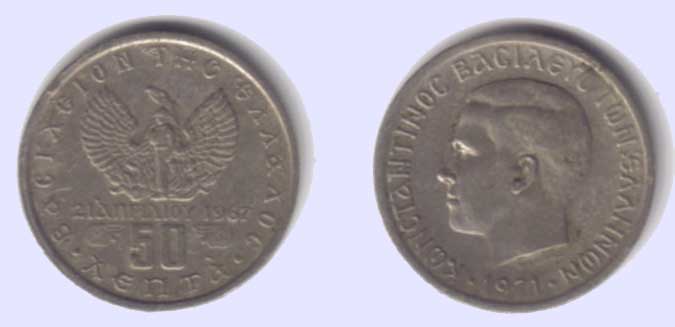
50 Lepta (1/2) Drachmae Coin from the year 1971 with the Phoenix and King Constantine II
See also
Biography portalflagGreece portal
Timeline of Greek history
History of modern Greece
List of Olympic medalists in sailing § Dragon class
Round Square
References
[1]
[2]
"Πέθανε ο τέως βασιλιάς Κωνσταντίνος". Kathimerini. 10 January 2023. Archived from the original on 11 January 2023. Retrieved 10 January 2023.
Hope, Kevin (November 2011). "Referendum plan faces hurdles". Financial Times. Archived from the original on 6 January 2012. Retrieved 19 November 2020.
"Constantine II", Encyclopædia Britannica Online Academic Edition, 2011, archived from the original on 1 December 2011, retrieved 12 November 2011, "On 1 June 1973, the military regime ruling Greece proclaimed a republic and abolished the Greek monarchy. A referendum on July 29, 1973, confirmed these actions. After the election of a civilian government in November 1974, another referendum on the monarchy was conducted on 8 December. The monarchy was rejected, and Constantine, who had protested the vote of 1973, accepted the result."
Meletis Meletopoulos (1994). "Κωνσταντίνος Β΄",Η βασιλεία στη Νεώτερη Ελληνική Ιστορία. Από τον Όθωνα στον Κωνσταντίνο Β΄ (in Greek). Athens: Nea Synora-AA Livani. p. 196.
Montgomery-Massingberd, Hugh, ed. (1977). Burke's Royal Families of the World. Vol. 1: Europe & Latin America. London: Burke's Peerage Ltd. pp. 327–28. ISBN 0-85011-023-8.
Curley, W.J.P. (1975). Monarchs In Waiting. London: Hutchinson & Co Ltd. pp. 39–41. ISBN 0-09-122310-5.
Tantzos 1990, p. 5.
Mateos Sáinz de Medrano 2004, p. 110-111.
Νεόλογος Πατρών (in Greek). No. 132. 4 June 1940. {{cite news}}: Missing or empty |title= (help)
"Naming practices" in British Academy and Oxford University, Lexicon of Greek Personal Names, online Archived 16 August 2018 at the Wayback Machine
Mateos Sáinz de Medrano 2004, p. 367.
Van der Kiste 1994, p. 159 and 161-162.
Hourmouzios 1972, p. 116.
Tantzos 1990, p. 15-16.
Van der Kiste 1994, p. 162-163.
Palmer & Greece 1990, p. 80.
Tantzos 1990, p. 18-20.
Mateos Sáinz de Medrano 2004, p. 113.
Vickers 2000, p. 292.
Van der Kiste 1994, p. 164.
Bertin 1982, p. 338.
Tantzos 1990, p. 20-21.
Mateos Sáinz de Medrano 2004, p. 189.
Mateos Sáinz de Medrano 2004, p. 114.
Mateos Sáinz de Medrano 2004, p. 113-115.
Hourmouzios 1972, p. 133.
Hourmouzios 1972, p. 136 og 144.
Tantzos 1990, p. 21.
Mateos Sáinz de Medrano 2004, p. 115-116.
Van der Kiste 1994, p. 170-171.
Hourmouzios 1972, p. 164-169 og 171.
Tantzos 1990, p. 38-39.
Hourmouzios 1972, p. 155.
Mateos Sáinz de Medrano 2004, p. 117.
Tantzos 1990, p. 61.
Mateos Sáinz de Medrano 2004, p. 359.
Packard, Ann (10 March 2012). "Obituary: Jocelin Winthrop-Young OBE, the Gordonstoun ethic ran deep in life and work of educationalist and Hahn disciple". The Scotsman..
Greek Civil War
Demetris Nellas (11 January 2023). "Constantine, the former and last king of Greece, dies at 82". Associated Press.
Montgomery-Massingberd, Hugh, ed. (1977). Burke's Royal Families of the World. Vol. 1: Europe & Latin America. London: Burke's Peerage Ltd. pp. 327–28. ISBN 0-85011-023-8.
Mateos Sáinz de Medrano 2004, p. 127.
Celada 2007, p. 70.
Mateos Sáinz de Medrano 2004, p. 120 og 131-132.
Mateos Sáinz de Medrano 2004, p. 120.
Mateos Sáinz de Medrano 2004, p. 124-125.
Hourmouzios 1972, p. 216 og 300.
"Απεβίωσε ο τέως βασιλιάς Κωνσταντίνος - Μητσοτάκης: «Η Ιστορία θα τον κρίνει δίκαια και αυστηρά»". Euronews (in Greek). 11 January 2023.
Tantzos 1990, p. 80-81.
"Ο τέως βασιλιάς Κωνσταντίνος μέσα από το ιστορικό αρχείο της «Κ»". Kathimerini (in Greek). 11 January 2023.
"Olympic Records World Records". Olympic. Archived from the original on 21 October 2013. Retrieved 12 August 2013.
"Ο τέως βασιλιάς Κωνσταντίνος μέσα από το ιστορικό αρχείο της «Κ»". Kathimerini (in Greek). 11 January 2023.
"Crown Prince Konstantinos". Sports Reference. 1 March 2020. Archived from the original on 18 April 2020. Retrieved 19 November 2020.
"ISA COMMITTEE MEMBERS". International Soling Association.
"IDA Officers". International Dragon Association.
"Ailing Greek King Names Son Regent". The New York Times. 21 February 1964. Archived from the original on 24 July 2016. Retrieved 29 April 2016.
Van der Kiste 1994, p. 184.
Mateos Sáinz de Medrano 2004, p. 135-136.
Tantzos 1990, p. 102-104.
Dimitrakis 2009, p. 107.
"Κωνσταντίνος Β': Ο τελευταίος Βασιλιάς της Ελλάδας". Sansimera (in Greek).
Kontogiannis, Panos (18 June 2017). "The July apostasy of 1965 in Greece; a royal coup to the regime of the colonels". Jason Institute for Peace and Security Studies.
Legg, Keith R. (1969). Politics in Modern Greece. Stanford UP. ISBN 0804707057.
Maniatis, Dimitris N. (14 January 2023). "Ο Κωνσταντίνος, τα Ιουλιανά του 1965 και ο δρόμος προς τη χούντα". In.gr (in Greek)..
Pantazopoulos, Yannis (13 January 2023). "Οι σκοτεινές σελίδες της ιστορίας του τέως βασιλιά Κωνσταντίνου". Lifo (magazine) (in Greek)..
Clogg, 1987, pp. 52
"Τα «Ιουλιανά» του 1965 και η «Αποστασία»". Sansimera (in Greek)..
Σήμερα .gr, Σαν. "Το Πραξικόπημα της 21ης Απριλίου 1967". Σαν Σήμερα .gr (in Greek). Retrieved 14 January 2023.
Clogg, 1987, pp. 53
Pelt, M. (2006). Tying Greece to the West: US-West German-Greek Relations 1949-1974. Studies in 20th & 21st century European history. Museum Tusculanum Press. p. 278. ISBN 978-87-7289-583-3. Retrieved 15 January 2023.
Chrysopoulos, Philip (21 April 2022). "April 21, 1967: Military Junta Places Greece in Shackles". Greek Reporter.
TV documentary "ΤΑ ΔΙΚΑ ΜΑΣ 60's – Μέρος 3ο: ΧΑΜΕΝΗ ΑΝΟΙΞΗ Archived 6 April 2008 at the Wayback Machine" Stelios Kouloglu
Dascarolis, Ioannis V. (11 January 2023). "Το στρατιωτικό κίνημα του Βασιλιά Κωνσταντίνου Β΄ κατά της Χούντας (13 Δεκεμβρίου 1967)". The Huffington Post (in Greek).
Kafantaris, Dimitris (15 January 2023). "Τέως βασιλιάς Κωνσταντίνος: Το χρυσό Ολυμπιακό μετάλλιο στη Ρώμη και οι γάμοι του". Vradyni (in Greek).
Hindley, G (1979). The Royal Families of Europe. London: Lyric Books Ltd. pp. 126–127. ISBN 0-07-093530-0.
"Greek Premier Supplants the Regent". The New York Times. 22 March 1972.
Eder, Richard (25 July 1974). "Constantine Declines to Predict When He Will Return to Greece". The New York Times.
"The Referendum". The Royal Chronicles. Archived from the original on 1 November 2020. Retrieved 19 November 2020.
Smith, Helena (15 December 2013). "Greece's former king goes home after 46-year exile". The Guardian. Archived from the original on 26 January 2021. Retrieved 30 March 2016.
Helena Smith (29 November 2002). "Court deals decisive blow to deposed Greek royals". The Guardian. Archived from the original on 26 August 2013. Retrieved 12 August 2013.
Bates, Stephen (12 January 2023). "King Constantine II of Greece obituary". The Guardian. Retrieved 16 January 2023.
"Throneless abroad: The men who would be king". Time. 3 June 2002. Vol. 159 No. 22.
Smith, Helena (15 December 2013). "Greece's former king goes home after 46-year exile". The Guardian. Archived from the original on 26 January 2021. Retrieved 3 March 2016.
"The Greeks are looking for a new strong leader". To Vima. Archived from the original on 25 April 2007. Retrieved 19 November 2020.
HM KING CONSTANTINE. greekroyalfamily.gr
The first volume of 'King Constantine' , 23 November 2015; http://www.tovima.gr/politics/article/?aid=756338 Archived 6 January 2017 at the Wayback Machine
"Former king of Greece, Constantine II, dies at 82". ABC News (Australia). Reuters. 11 January 2023. Retrieved 10 January 2023.
"Last king of Greece, Constantine II, dies aged 82". The Guardian. 10 January 2023. Archived from the original on 11 January 2023. Retrieved 10 January 2023.
Nellas, Demetris. "Constantine, the former and last king of Greece, dies at 82". ABC News. Archived from the original on 11 January 2023. Retrieved 11 January 2023.
Maung, Carole Aye (5 September 1997). "Our Auntie Diana". The Mirror. Archived from the original on 13 April 2014. Retrieved 15 June 2013.
"Why European Royalty and Aristocrats are flocking to New York". Gotham. Archived from the original on 9 May 2015. Retrieved 1 February 2015.
"King Without a Country". Vanity Fair. July 1995. p. 47
Βραβορίτου, Αγνή (25 April 2003). Δεν περνάει η μπογιά του. Eleftherotypia (in Greek). Χ. Κ. Τεγόπουλος Εκδόσεις Α.Ε. Archived from the original on 18 February 2013. Retrieved 1 September 2011.
Question "S 3937" to the Minister of Justice (11 September 2001) Archived 12 December 2008 at the Wayback Machine. Folketinget.dk. Retrieved on 9 April 2016.
HM King Constantine Archived 13 February 2011 at the Wayback Machine. International Olympic Committee. Retrieved on 2016-09-16.
"FAQ". Official website of the Greek royal family. Archived from the original on 3 June 2020. Retrieved 3 June 2020. "The correct form of address is: King Constantine, former King of the Hellenes and so on for the family members."
Charles Kidd; David Williamson (1999). Macmillan (ed.). Debrett's Peerage and Baronetage 2000. p. 86. ISBN 033354577X.
Кавалеры 1-й степени. Saintanna.Ru. Retrieved on 9 April 2016.
List of recipients. Saintanna.Ru (16 February 2015). Retrieved on 2016-04-09.
"Membership of the Constantinian Order". Sacred Military Constantinian Order of Saint George. 2008. Archived from the original on 18 July 2011. Retrieved 13 October 2008.
䝪䞊䜲䝇䜹䜴䝖日本連盟 きじ章受章者 [Recipient of the Golden Pheasant Award of the Scout Association of Japan] (PDF). Reinanzaka Scout Club (in Japanese). 23 May 2014. Archived from the original (PDF) on 11 August 2020.
"Official Website: Beppe Croce". Sailing. 21 February 2012. Archived from the original on 25 September 2012. Retrieved 12 August 2013.
Bibliography
Bertin, Celia (1982). Marie Bonaparte. Paris: Perrin. ISBN 2-262-01602-X..
Celada, Eva (2007). Irene de Grecia: La princesa rebelde (in Spanish). Plaza & Janés. ISBN 978-84-01-30545-0.
Dimitrakis, Panagiotis (2009). Greece and the English. British Diplomacy and the Kings of Greece. London: Tauris Academic Studies. ISBN 978-1-84511-821-1.
Hourmouzios, Stelio (1972). No Ordinary Crown. A Biography of King Paul of the Hellenes. Weidenfeld & N. ISBN 0-297-99408-5.
Mateos Sáinz de Medrano, Ricardo (2004). La Familia de la Reina Sofía, La Dinastía griega, la Casa de Hannover y los reales primos de Europa (in Spanish). Madrid: La Esfera de los Libros. ISBN 978-8-4973-4195-0. OCLC 55595158.
Palmer, Alan; Greece, Michael of (1990). The Royal House of Greece. London: Weidenfeld Nicolson Illustrated. ISBN 978-0-2978-3060-3.
Tantzos, Nicholas (1990). H.M. Konstantine XIII : King of the Hellenes. Atlantic International Publications. ISBN 0-938311-12-3.
Van der Kiste, John (1994). Kings of the Hellenes. The Greek Kings, 1863-1974. Sutton Publishing. ISBN 978-0-7509-2147-3..
Woodhouse, C.M. (1998). Modern Greece a Short History. London: Faber & Faber. ISBN 0-571-19794-9.
Γιάννης Κάτρης (1974). Η γέννηση του νεοφασισμού στην Ελλάδα 1960–1970. Athens: Παπαζήση.
Αλέξης Παπαχελάς (1997). Ο βιασμός της ελληνικής δημοκρατίας. Athens:Εστία. ISBN 960-05-0748-1.
ΜΑΡΙΟΣ ΠΛΩΡΙΤΗΣ:Απάντηση στον Γκλύξμπουργκ, Εφημερίδα Το ΒΗΜΑ, Κυριακή 10 Ιουνίου 2001 – Αρ. Φύλλου 13283
ΜΑΡΙΟΣ ΠΛΩΡΙΤΗΣ:Δευτερολογία για τον Γκλύξμπουργκ, Εφημερίδα Το ΒΗΜΑ, Κυριακή 24 Ιουνίου 2001 – Αρ. Φύλλου 13295
ΣΤΑΥΡΟΣ Π. ΨΥΧΑΡΗΣ: H ΣΥΝΤΑΓΗ ΤΗΣ ΚΡΙΣΗΣ, Εφημερίδα Το ΒΗΜΑ, 17/10/2004 – Κωδικός άρθρου: B14292A011 ID: 265758
Constantine II of Greece (2015). "Βασιλεύς Κωνσταντίνος". Athens: To Vima. ISBN 978-960-503-693-5.
Καδδάς, Αναστάσιος Γ. (2010). "Η Ελληνική Βασιλική Οικογένεια". Athens: Εκδόσεις Φερενίκη. ISBN 978-960-9513-03-6.
Vickers, Hugo (2000). Alice: Princess Andrew of Greece. St. Martin's Griffin. ISBN 9780312302399.
| Ancient Greece
Science, Technology , Medicine , Warfare, , Biographies , Life , Cities/Places/Maps , Arts , Literature , Philosophy ,Olympics, Mythology , History , Images Medieval Greece / Byzantine Empire Science, Technology, Arts, , Warfare , Literature, Biographies, Icons, History Modern Greece Cities, Islands, Regions, Fauna/Flora ,Biographies , History , Warfare, Science/Technology, Literature, Music , Arts , Film/Actors , Sport , Fashion --- |
Retrieved from "http://en.wikipedia.org"
All text is available under the terms of the GNU Free Documentation License

